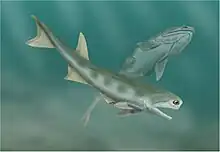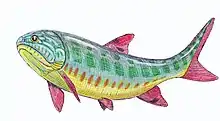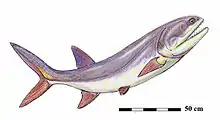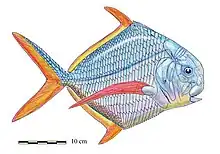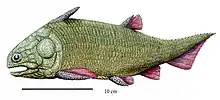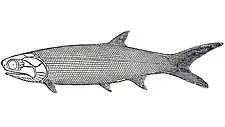Urosthenes
Urosthenes is an extinct genus of prehistoric bony fish that lived during the Lopingian (late Permian) to Middle Triassic epochs in what is now New South Wales, Australia.[2]
| Urosthenes Temporal range: | |
|---|---|
| Scientific classification | |
| Kingdom: | |
| Phylum: | |
| Class: | |
| Order: | |
| Family: | †Urostheneidae |
| Genus: | †Urosthenes Dana, 1848 |
| Type species | |
| †Urosthenes australis Dana, 1848 | |
| Other species | |
| |
The type species is U. australis, described from Middle Triassic deposits. The second species, U. latus, was found in Permian (Wuchiapingian?) aged rock layers and was first described in 1931 by Arthur Smith Woodward, based on a specimen found in Lithgow, New South Wales.[3]
Appearance
Urosthenes had a short and round body with large and veil-like fins almost symmetrical in shape. The ventral fins were closer to the head and also were quite large compared to the body, and similarly the dorsal and anal fins. Contrary to most other archaic actinopterygians, Urosthenes had very thin scales.[3]
References
- "Palaeonisciformes". Paleobiology Database. Retrieved 19 Nov 2012.
- Romano, Carlo; Koot, Martha B.; Kogan, Ilja; Brayard, Arnaud; Minikh, Alla V.; Brinkmann, Winand; Bucher, Hugo; Kriwet, Jürgen (2016). "Permian-Triassic Osteichthyes (bony fishes): diversity dynamics and body size evolution". Biological Reviews. 91 (1): 106–147. doi:10.1111/brv.12161. PMID 25431138. S2CID 5332637.
- Woodward, Arthur Smith (1931-10-01). "XLVII.—On Urosthenes, a fossil fish from the Upper Coal Measures of Lithgow, New South Wales". Annals and Magazine of Natural History. 8 (46): 365–367. doi:10.1080/00222933108673406. ISSN 0374-5481.
